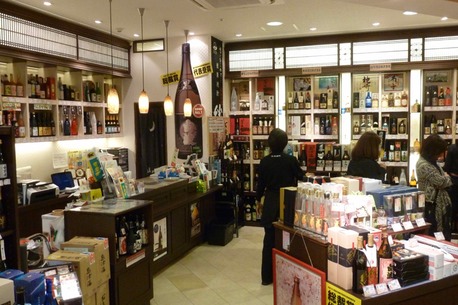In any case, a leisurely morning was the order of the day, and I lobbed myself gently towards the shower rather than hurling myself into the rain room. Breakfast on both days was good deal for the ¥500, and you could see why most of the occupants of the hotel's three hundred and fifty plus rooms would be inclined to eat there rather than elsewhere.
Still, it was relatively uncrowded when we made our way downstairs around eight-thirty, hit the breakfast options and wandered back up, passing the impressive display of bottles associated with one of Kagoshima’s other claims to fame, the sweet potato shōchū (imo-jochu). Typically distilled from barley, sweet potatoes, or rice, though it can be made from brown sugar, buckwheat, sesame and chestnut, shōchū is a completely different beast to sake, though if you're in Kagoshima and ask for the latter you'll almost certainly be served shōchū instead. There are, by all accounts, hundreds of different brands, and a fair few of them were represented in the display.
Kagoshima is the only prefecture in Japan that doesn't brew any sake at all, and the spirit dates back to at least the mid-16th century, arriving in the country through Kagoshima from China or Korea. There's a reference in a piece of temple grafitti written by a carpenter in 1559. Apparently the abbot at the particular shrine was less forthcoming with the spirit than his workers would have liked.
Madam had intentions of sampling the local product, but hadn't managed to do so over the preceding day and a half. With plenty of time till the train left she could still have done so, right up to the time we boarded the train, since the Shinkansen platforms at Kagoshima-chuo have bars offering more than a hundred varieties.Instead, having made our way over to Kagoshima-chuo I set off in search of the statue commemorating the fifteen young men from Satsuma who broke the Tokugawa Shogun’s ban on foreign travel, travelling to England and the United States to study Western science and technology, an adventure that did much to kickstart Japan's industrial revolution. I’d spotted the item in question while Madam was scoping out the transport options between station and hotel, had promptly forgotten all about it the following day but now, with the best part of an hour left till the train departed looking for it was a decent way of killing time.
 Had I done a head count I’d probably have found only fifteen there, though the party included a recruit from from Tosa and another fom Nagasaki, and apparently there were a couple of supervisors along for the ride as well. They studied at University College London, and many went on to Oxford and Cambridge before returning home. Among their number was Mori Arinori, the first Japanese ambassador to the USA and, subsequently, Minister for Education, Godai Tomoatsu (founder of the the Osaka Chamber of Commerce and the Osaka Stock Exchange) and Terashima Munenori, who went on to become Japan’s Foreign Minister.
Had I done a head count I’d probably have found only fifteen there, though the party included a recruit from from Tosa and another fom Nagasaki, and apparently there were a couple of supervisors along for the ride as well. They studied at University College London, and many went on to Oxford and Cambridge before returning home. Among their number was Mori Arinori, the first Japanese ambassador to the USA and, subsequently, Minister for Education, Godai Tomoatsu (founder of the the Osaka Chamber of Commerce and the Osaka Stock Exchange) and Terashima Munenori, who went on to become Japan’s Foreign Minister.
With that done there was still time to kill, so we loitered around the station’s shopping precinct, noting a rather interesting poster advertising a newspaper and sending Madam off to perambulate through the local delicacies on sale to the travelling public. As stated elsewhere this kind of thing is an important consideration in a gift-giving culture and she didn’t return empty-handed.Once she’d made her way back with a selection of goodies I took a turn around the same area, somehow managing to arrive in the Shōchū Store, though they didn’t seem to be offering samples.
More...